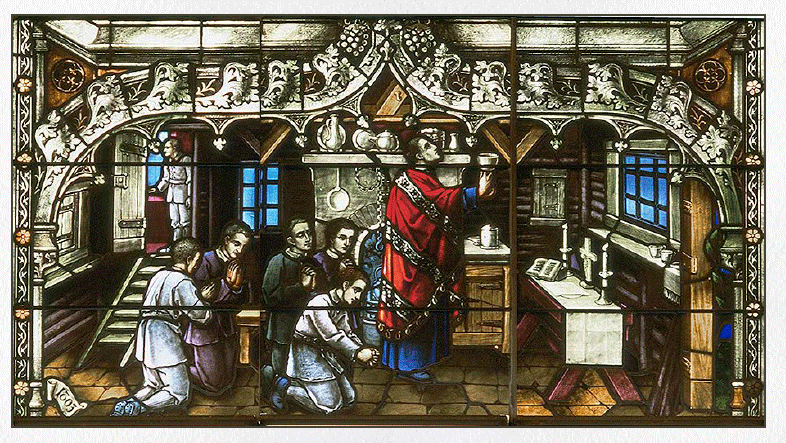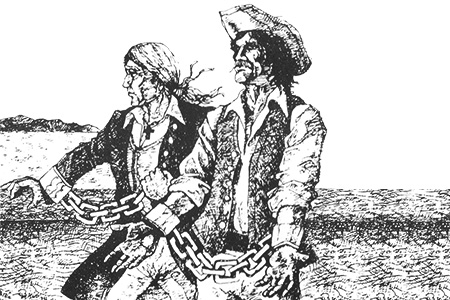The story of James Dempsey and John Butler
1802-1838
Although the first official Carmelites foundation in this country was made in 1881, the first Carmelites in Australia had arrived nearly eighty years before. They were the Lay Carmelites (Tertiaries or Confraternity members) James Dempsey and John Butler. Both were transported to Botany Bay for life for their alleged involvement in the Irish Rebellion of 1798.
There is no record of their offence or trial, but that is not unusual for Rebellion Prisoners, for suspects were often given summary trial by courts martial or even simply rounded up and transported without trial. They arrived in Sydney aboard the Atlas in October 1802. We know that Dempsey left behind him a wife and four children.
Both men were stonemasons, and were soon at work on government projects: Butler at Castle Hill quarry, and Dempsey on various works, including the Tank Stream bridge, and later the military barracks and the Rum Hospital. He was one of the first of the Atlas prisoners to gain a free pardon, in 1811. Butler received a conditional pardon in 1814 and a free pardon in 1827.
Three priests were among the Rebellion prisoners, but their ministry was severely restricted, and by 1810 all had returned to Ireland. For the next ten years, apart from a few months in 1817-18, there was no priest in Australia
What little evidence we have of those years indicates that Dempsey was virtually the centre of Catholic life in the colony. He accompanied the condemned with prayers to the scaffold, and made his Kent Street house a social and religious centre. There the rosary was said on weekdays and Vespers recited on Sundays. It was there that a Mr McGuire and Mrs Fitzpatrick taught the children their catechism and ran a little choir.
In 1817 Fr Jeremiah O'Flynn arrived in the colony, only to be deported by Governor Macquarie six months later. By accident or design he left the Blessed Sacrament at Kent Street. James Dempsey turned the best room in his house into a little chapel, and formed a small confraternity of men to watch over the Blessed Sacrament. John Butler, his fellow Carmelite, was one of the members.
Stained Glass window in St Mary's Cathedral commemorating the Mass celebrated by Fr O'Flynn in Dempsey's house
Columbus Fitzpatrick, an eyewitness, says that on Sundays the worshippers used to overflow onto the veranda and even into the street, "much to the amusement of the scoffers, who said we ought to be sun-struck". He adds that when a French ship, the Uranie, called at Sydney, its gallant officers knelt down to worship "with poor Irish in that small room, in that obscure house", much to the astonishment of the Protestants.
Frs Therry and Conolly, the first official Catholic chaplains, arrived in 1820. Soon plans were afoot for a church, the first Saint Mary's Cathedral, which was to burn down in 1865. James Dempsey was superintendent of construction and also one of the chief fund-raisers for the project. He even made a disappointing trip to India in 1826 to raise money for Saint Mary's (the bishop of Calcutta gave only ten rupees).
From the beginning Fr Therry's chaotic approach to finance brought trouble to the project. Dempsey's struggle to keep it going included advancing £300 of his own money. A modern historian, James Waldersee, writes that "the more we learn of James Dempsey's role in building the first Saint Mary's the more we must wonder whether it could ever have been completed without him".
Some of Dempsey's letters to Fr Therry have survived. They reveal a strong, spiritual, humble man. He was evidently not well-educated, and was a stranger to punctuation and spelling, but was not afraid to speak his mind. He resigned in frustration more than once from the Saint Mary's project, and in a letter of 1830 he deplores the bad feeling that had grown up between Fathers Therry and Power, urging Therry that "he that would humbel himself the most would be the gratest" (sic). A letter from John Butler also survives, in which he asks Fr Therry to attend at the gaol to a man named Webb, who was to hang the following day.
James Dempsey died in 1838. His son, Cornelius, had joined him in 1821 and settled on the Shoalhaven. There are still Dempsey descendants in Bega and Sydney. John Butler died in 1836. There is a tradition that during his lifetime he was known around Sydney as 'The Carmelite', and his gravestone, which can still be seen in Sydney's Botany Cemetery, depicts the scapular and proudly announces him to have been "a lay Carmelite brother and one of the members of the Confraternity of St Joseph".
Fr Paul Chandler OCarm
In 2017 the Archdiocese of Sydney announced the inaugural Dempsey Medal commemorating Dempsey's pioneering contribution to the Catholic community of Sydney.
pdf
Read more about the award.
















